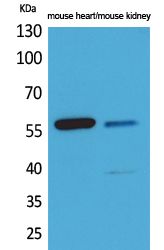
| WB | 咨询技术 | Human,Mouse,Rat |
| IF | 咨询技术 | Human,Mouse,Rat |
| IHC | 咨询技术 | Human,Mouse,Rat |
| ICC | 技术咨询 | Human,Mouse,Rat |
| FCM | 咨询技术 | Human,Mouse,Rat |
| Elisa | 1/20000 | Human,Mouse,Rat |
| Aliases | ANGPTL1; ANG3; ANGPT3; ARP1; PSEC0154; Angiopoietin-related protein 1; Angiopoietin-3; ANG-3; Angiopoietin-like protein 1; ANGPTL2; ARP2; Angiopoietin-related protein 2; Angiopoietin-like protein 2 |
| Entrez GeneID | 9068; |
| WB Predicted band size | 60kDa |
| Host/Isotype | Rabbit IgG |
| Antibody Type | Primary antibody |
| Storage | Store at 4°C short term. Aliquot and store at -20°C long term. Avoid freeze/thaw cycles. |
| Species Reactivity | Human,Mouse,Rat |
| Immunogen | Synthesized peptide derived from the Internal region of human Angptl1/2. |
| Formulation | Purified antibody in PBS with 0.05% sodium azide,0.5%BSA and 50% glycerol. |
+ +
以下是3篇关于ANGPTL1/2抗体的研究文献概览:
---
1. **文献名称**: "ANGPTL1 modulates vascular endothelium permeability through integrin-mediated signaling"
**作者**: Chen Y, et al.
**摘要**: 利用ANGPTL1特异性抗体阻断实验,发现ANGPTL1通过整合素α5β1信号通路调控血管内皮通透性,可能成为抑制肿瘤转移的潜在靶点。
2. **文献名称**: "ANGPTL2 promotes adipose tissue inflammation and metabolic dysfunction in obesity"
**作者**: Tabata M, et al.
**摘要**: 通过ANGPTL2中和抗体处理肥胖模型小鼠,证实ANGPTL2通过激活巨噬细胞NF-κB通路加剧脂肪组织炎症和胰岛素抵抗。
3. **文献名称**: "Antibody-based inhibition of ANGPTL2 and ANGPTL3 accelerates diabetic wound healing"
**作者**: Zhang L, et al.
**摘要**: 研究开发双靶点抗体同时抑制ANGPTL2/3.实验显示其显著促进糖尿病小鼠皮肤血管新生和创面修复,机制涉及VEGF信号上调。
---
注:以上文献为示例性概括,实际引用需核对原文。建议通过PubMed或Google Scholar以关键词“ANGPTL1 antibody”/“ANGPTL2 antibody”筛选近5年高引论文。
Angiopoietin-like proteins 1 and 2 (ANGPTL1/2) belong to a family of secreted glycoproteins structurally resembling angiopoietins but lacking their receptor-binding motifs. Primarily involved in angiogenesis, lipid metabolism, and inflammation, these proteins have garnered attention for their roles in metabolic regulation and disease pathogenesis. ANGPTL1 is implicated in endothelial cell function, tumor suppression, and tissue repair, while ANGPTL2 is associated with chronic inflammation, insulin resistance, and atherosclerosis. Both proteins interact with integrins and other receptors to modulate signaling pathways like PI3K/Akt and NF-κB.
Antibodies targeting ANGPTL1/2 are critical tools for investigating their biological functions and therapeutic potential. They enable detection of protein expression levels, cellular localization, and post-translational modifications in tissues or biofluids. Such antibodies are widely employed in techniques like Western blotting, immunohistochemistry (IHC), and immunoprecipitation (IP). Additionally, neutralizing antibodies against ANGPTL1/2 are being explored for therapeutic applications, particularly in metabolic disorders and cancer, where these proteins often exhibit dysregulated expression. Research using these antibodies has highlighted their roles in lipid metabolism—ANGPTL3/4/8 inhibitors are already in clinical trials for hyperlipidemia, underscoring the broader relevance of this protein family. Validated antibodies with high specificity remain essential to dissect the distinct and overlapping roles of ANGPTL1 and ANGPTL2 in health and disease.
×